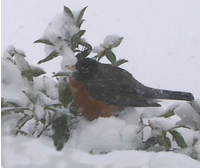|
How is this robin staying warm? |
|
| Journey North's robin expert, Laura Erickson, says: | |
|
Seeking Shelter: During storms, birds try to get as sheltered as they can. Like this robin, they take shelter in bushes, near buildings, or in trees. (No nests! Nests are not shelters, but only cradles for baby robins.) Fluffing Feathers: What do you notice about the robin's feathers? The bird fluffed his feathers to protect himself from the cold. This fluffiness is important. It insulates the bird’s internal organs so they stay at 104° F. Feathers themselves are such good insulators that the outside of the feather is cold, like the air. But, just a few millimeters under the feathers, the bird's body is a cozy 104°F. Snow doesn’t melt on cold feathers, so the feathers stay dry. What about cold feet? A bird’s feet don’t have much blood flow. Still, birds fluff their belly feathers to help cover the toes and keep them warm. BONUS: What is the temperature difference between the air and the bird’s heart and lungs if it's 6° F outside? Answer: Almost 100 degrees! (104°F - 6°F = 98°F.) Now you see the importance of those fluffed-up feathers! |
|
